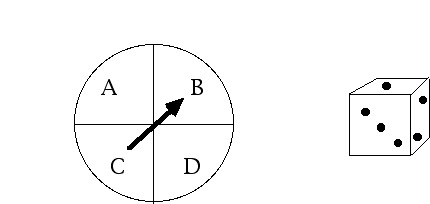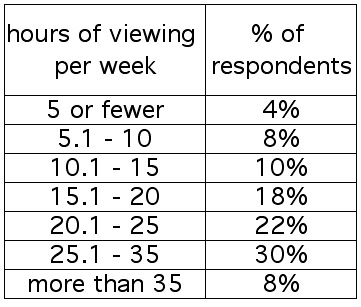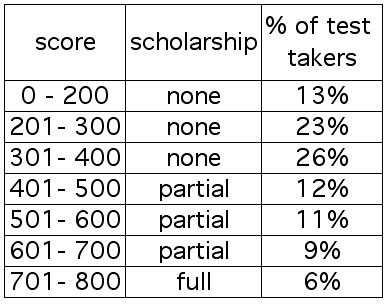INDEPENDENT EVENTS and THE MULTIPLICATION RULES
EXAMPLE 3.5..1
Suppose we have one six-sided die, and a spinner such as is used in a child's game. When we spin the spinner, there are four equally likely outcomes: "A," "B," "C," and "D."

An experiment consists of rolling the die and then spinning the spinner.
How many different outcomes are possible?
What is the probability that the outcome will be "3-C?"
see solution
The MULTIPLICATION RULE for INDEPENDENT EVENTS
If E and F are independent events, then
![]()
Recall this (authentic) data from the Natural Resources Defense Council:
40% of bottled water samples are merely tap water.
30% of bottled water samples are contaminated by such pollutants as arsenic and fecal bacteria.
If two samples are independently selected, what is the probability that both samples are
contaminated by pollutants?
see solution
EXAMPLE 3.5..3
Suppose that survey of hawks reveals that 40% of them agree with the
statement "Poodles are tasty." If two hawks are independently selected, what is the probability that neither of them agree that "Poodles are tasty?"
A. .8
B. .6
C. .36
D. .64
see solution
INDEPENDENT EVENTS, DEPENDENT EVENTS
Two events A and B are said to be independent if they do not influence one
another. More formally, this means that the occurrence of one event has no effect upon
the probability of the other event.
Click here for further discussion of dependence and independence of events
EXAMPLE 3.5..5
At the entrance to a casino, there are two slot machines.
Machine A is programmed so that in the long run it will produce a winner in 10% of the plays.
Machine B is programmed so that in the long run it will produce a winner in 15% of the plays.
1. If we play each machine once, what is the probability that we will win on both plays?
2. If we play each machine once, what is the probability that we will lose on both plays?
3. If we play each machine once, what is the probability that we will win on at least one play?
see solution
EXAMPLE 3.6.6
According to a study in 1992 by the U.S. Department of Agriculture, 80% of commercially grown
celery samples and 45% of commercially grown lettuce samples contain traces of agricultural
poisons (insecticides, herbicides, fungicides).
If Homer eats one serving (one sample) of celery and one serving of lettuce:
1. What is the probability that both the celery and the lettuce contain traces of agricultural poisons?
2. What is the probability that neither serving contains traces of agricultural poisons?
3. What is the probability that at least one of the servings contains traces of agricultural poisons?
see solution
EXAMPLE 3.5..7
Real data (as of 1999):
Each day, 7% of the US population eat a meal at McDonald's.
If two people are randomly and independently selected, what is the probability that...
1. ...both people will eat a meal at McDonald's today?
2. ...neither person will eat a meal at McDonald's today?
3. ...at least one of them will eat a meal at McDonald's today?
General Note:
In any situation in which two or more individuals are chosen from a large population of unspecified size, we will
assume that the selections are independent events.
click here for further comment
EXAMPLE 3.5..8
The table below shows the results of a survey of TV viewing habits:

Assume that Homer and Gomer are a couple of randomly selected, independent guys.
According to the data in the table above, what is the probability that:
1. Homer views TV for 5 or fewer hours per week, and Gomer views TV for 10.1 - 20 hours per week?
2. Homer views TV for 35 or fewer hours per week, and so does Gomer?
Still assuming that Homer and Gomer are a couple of randomly selected, independent guys:
3. What is the probability that neither of them falls in the 15.1 - 20 hours per week category?
4. What is the probability that at least one of them views TV for 15.1 - 20 hours per week?
see solutions
EXAMPLE 3.5..9
A university awards scholarships on the basis of student performance on a certain placement test.
The table below indicates the distribution of scores on that test.

If Homer and Gomer are a couple of randomly selected, independent guys, what is
the probability that neither of them received a scholarship?
Recall the following scenario from Unit 3 Module 5:
EXAMPLE 3.5.1*
According to a recent article from the New England Journal of Medical Stuff ,
63% of cowboys suffer from saddle sores,
52% of cowboys suffer from bowed legs,
40% suffer from both saddle sores and bowed legs.
What is the probability that a randomly selected cowboy...
4. ...has saddle sores and bowed legs?
Let's answer this question again, using the Multiplication Rule for Independent events.
Let E be the event "the randomly selected cowboy has saddle sores." Then P(E) = .63.
Let F be the event "the randomly selected cowboy has bowed legs." Then P(F) = .52.
According to the multiplication rule,
![]()
This seems very nice, until we notice that the data provided in the problem states directly that P(E and F) = .40.
The question now becomes: What's wrong here?
Why does the Multiplication Rule not give the correct answer?
Does this mean that the Multiplication Rule is not reliable? Is this evidence of a rip in the very fabric of space/time, perhaps signaling the impending destruction of the universe as we know it?
click here to get a hint
CONDITIONAL PROBABILITY
On the Impossibility of Tuesday
A dialogue
Homer: It's Tuesday.
Gomer: Are you sure?
Homer: Sure I'm sure.
Gomer: Really? But it can't be Tuesday, can it?
Homer: Of course it's Tuesday. Yesterday was Monday, today is Tuesday.
Gomer: But that's exactly the problem.
Homer: What problem?
Gomer: The problem of Tuesday. It can't be Tuesday.
Homer: Whatever.
Gomer: Look, there are seven days in a week, right?
Homer: Last time I checked.
Gomer: So if I just woke up from a coma--
Homer: --that would be a nice change--
Gomer: --if I just woke up from a coma, and didn't know what day it was, the probablity that today
is Tuesday would be one seventh, right?
Homer: Right; one out of seven.
Gomer: But in order for today to be Tuesday, yesterday must have been Monday.
Homer: It follows.
Gomer: Actually, it precedes. But the probability that yesterday was Monday is also one seventh,
so the probability that yesterday was Monday AND today is Tuesday is only one seventh of one seventh...
Homer: ...The multiplication rule.
Gomer: Right, so that's only one out of 49. And it gets worse. In order for yesterday to have been Monday, the day before
yesterday would have had to have been Sunday...
Homer: ...so the probability that the day before yesterday was Sunday, AND yesterday was Monday,
AND today is Tuesday...
Gomer: ...is one seventh of one seventh of one seventh...
Homer: ...which is only, let's see, (mumbles, makes calculations in the air with finger, carries the one, et c)
one out of 343, I guess. Dang. Maybe today isn't Tuesday, after all.
Gomer: Now, I'm especially worried, because it occured to me that in order for the day before yesterday
to have been Sunday, the day before that would have had to have been Saturday, so (let's work backward here) the probability
that today is Tuesday AND yesterday was Monday AND the day before yesterday was Sunday AND the
day before that was Saturday...
Homer: ...is one seventh of one seventh of one seventh of one seventh, which is ...
Gomer: ...one out of 2401.
Homer: Hey, you're pretty quick with that.
Gomer: Well, I've been researching the matter. In fact, I found out that if you take this
back as far as a week and a half, it's obvious that the probability that today is Tuesday is
only about one in 282 million.
Homer: A virtual impossibility!
Gomer: So, I wonder what day it is.
Homer: Me too, now that you've explained the situation to me.
Gomer: One thing's for sure.
Homer: You've got that right. One thing's for sure: today isn't Tuesday.
Gomer: Exactly.
Homer: It's a virtual impossibility.
Gomer: There is a bright side, though.
Homer: And that is?
Gomer: Well, I was supposed to have a math test on Tuesday, but I haven't been studying.
Homer: Clearly, you've had more important fish to fry.
Gomer: Well put; I've been wrestling with this "impossibility of Tuesday" issue for quite a while.
At least one thing is virtually certain: my math test can't be today.
Homer: It's virtually impossible.
Gomer: That's a relief.
Homer: Every cloud has its silver lining. I have get going, though. I have term paper due tomorrow.
Gomer: Wednesday?
Homer: Yeah. Wednesday morning, eight o'clock sharp.
Gomer: But it's virtually impossible that tomorrow will be Wednesday...
EXAMPLE 3.5..18
An IRS auditor has a list of 12 taxpayers whose tax returns are questionable.
The inspector will choose 2 of these people to be audited. Eight of the taxpayers
are Floridians and 4 are Georgians. What is the probability that both people selected
will be Floridians?
THE MULTIPLICATION RULE FOR DEPENDENT EVENTS.
If E and F are dependent, then
![]()
This rule is especially useful when we have a two-step experiment where the outcome of the
first step affects the possible outcomes for the second step, such as the previous example.
INDEPENDENT vs. DEPENDENT EVENTS
In a case where two or more items are selected from a large population of unspecified size, we will
assume that the selections are INDEPENDENT. In a case where two or more items are selected from
a small population of specified size, we will assume that the selections are DEPENDENT.
EXAMPLE 3.5..19
In his pocket, Gomer has 3 red, 5 orange and 2 blue M&Ms.
If he randomly chooses two M&Ms, what is the probability that both will be red?
A. .6
B. .09
C. .067
D. .52
see solution
EXAMPLE 3.5..20
The Skuzuzi Kamikaze sport/utility vehicle is manufactured at two plants,
one in Japan and one in the US. Sixty percent of the vehicles are made in the US,
while the others are made in Japan. Of those made in the US, 5% will be recalled
due to a manufacturing defect. Of those made in Japan, 3% will be recalled.
Find the probability that a vehicle will be...
1. ...made in the US and not recalled.
2. ...made in Japan and recalled.
see solution
EXAMPLE 3.5..21
The state insurance commission revealed the following information about the
Preferential Insurance Company's homeowners' insurance: 10% of the policy-holders
have filed more than 5 claims over the past two years; 60% of these people have had
their insurance canceled; 90% of the policy-holders have filed 5 or fewer claims over
the past two years; 15% of these people have had their insurance canceled.
What is the probability that a policy holder filed more than 5 claims over the past
2 years and had his/her insurance canceled?
Once again, let's turn our attention to this scenario from Unit 3 Module 5:
EXAMPLE 3.5.1**
According to a recent article from the New England Journal of Medical Stuff ,
63% of cowboys suffer from saddle sores,
52% of cowboys suffer from bowed legs,
40% suffer from both saddle sores and bowed legs.
What is the probability that a randomly selected cowboy has saddle sores and bowed legs?
We know that the answer is .40, because that information is stated directly in the problem. Earlier
we saw, however, that if we try to derive this answer by using the Multiplication Rule for Independent
Events, we fail because (.63)(.52) is NOT equal to .40.
Let's try again, using the correct version of the Multiplication Rule.
see solution
EXAMPLE 3.5..22
A local sports talk radio station offers the following contest: each Thursday during the
football season, listeners are invited to call the station and make
four predictions "against the spread." The caller may choose any four
college or professional games he/she desires, as long as they are games for which the
odds makers have issued a betting line.
Any caller who turns out to be correct on all four predictions will win a $10 bar tab
from a local sports bar. If we assume that each week 25 callers will get on the air
with their predictions, what will be the expected weekly cost in bar tabs to the bar
that sponsors the program? (In order to answer this question, we need to make a reasonable
assumption about the significance of "beating the point spread.")
EXAMPLE 3.5..23
The world famous Car and Goats problem
You are a contestant on the extinct TV game show Let's Make a Deal.
On the stage, there are three large doors. Behind one door is a new car;
behind the other two doors are goats. You are asked to pick one of the doors.
You win whatever prize is behind the door that you pick.
You choose a door. Before he reveals your prize, the host opens one of the
doors that you didn't pick, and shows you that there was a goat behind that door.
There are still two unopened doors. You have chosen one of them. You now know for
sure that behind one of the two doors is a car, and behind the other door is a goat.
The host asks you if you want to change your choice of doors.
Is there any mathematical reason why you should switch?
To decide whether or not it is advantegeous to switch, answer the following questions:
What is the probability that you will win a car by switching?
What is the probability that you won't win a car by switching?
These two questions are easy to answer, if you think carefully about the underlying conditions:
How could you win (a car) by switching?
How could you lose by switching?
EXAMPLE 3.5..24
The "Year-ending-in-zero" presidential curse
It is a well-known fact from American history that presidents who are elected in years
ending with "0," such as 1840, 1960, 1900, and so forth,
tend to have fatally bad luck.
Of those presidents elected in years ending with "0," (not counting the president elected in 2000)
7 have died in office
5 have been shot
4 have been shot and died in office
2 have neither been shot nor died in office
Find the probability that a president elected in a year ending with zero...
1. ...died in office or was shot.
2. ...was shot but didn't die in office.
3. ...was shot, given that he died in office.
4. ...didn't die in office, given that he was shot.
Download practice exercises (PDF file)